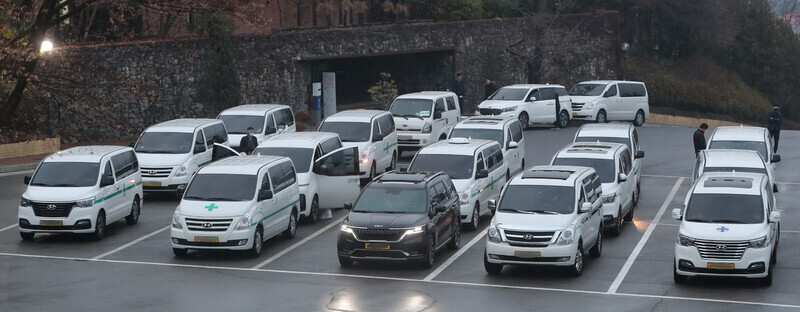hankyoreh
Links to other country sites 다른 나라 사이트 링크
[Reportage] At one S. Korean crematorium, ambulances carrying COVID-19 dead arrived one after another

Around 4 pm on Friday, ambulances began pulling up a foggy hill to the Seoul Crematorium in Goyang, Gyeonggi Province, carrying the bodies of people who had died from COVID-19.
The vehicles ferrying them to their final resting place were not hearses decorated in commemorative flowers, but hospital ambulances. Following behind were vehicles carrying a small number of family members on their way to take one last look at their loved ones.
By 5 pm, the parking lot in front of the crematorium grate was packed with 20 or so ambulances alone.
The crematorium starts its cremations of COVID-19 victims at 5:30 pm, waiting until after its ordinary cremations are all complete. Twelve COVID-19 victims had been brought there before 11 am that day, coming from hospital funeral homes throughout the greater Seoul area. Twenty COVID-19 victims in all were cremated at the crematorium that day.
Disease control guidelines stipulate that family members cannot enter the crematorium. This leaves them only around three minutes to take a last look at their loved ones.
While the coffins are being moved by six people dressed in full-body protective gear, including the ambulance drivers and crematorium staff, the family members remain at a distance of around 50 feet as they say goodbye. In some cases, they were unable to speak, wordlessly wiping away tears when the crematorium staff asked them to say any final words.
With so little time for their farewell, some of the family members took cell phone videos from afar as their loved one’s body was taken inside the building.
Even during those brief moments, staff members worked to sterilize the route that the bodies were being taken along. Three minutes later, another waiting ambulance pulled up to the building entrance. The parade of farewells continued at three-minute intervals even after the sun had set.
Some of the family members were visibly distraught at being unable to follow their loved ones all the way on their last journey.

“I couldn’t even properly tend to him, and I had to watch on closed-circuit cameras while he was going on his way,” said a 50-year-old woman who was saying goodbye to her 84-year-old father-in-law.
“All the clothes he’d been wearing were burned, which left his resident registration card as his last personal effect,” she added.
“With the COVID-19 situation, everything’s been so disconcerting and chaotic. We couldn’t even have a funeral, and today it’s just the five of us family members who came.”
For COVID-19 deaths, the rule has been “cremations first, funerals later.”
As of the end of the day Thursday, 1,281 people in South Korea had passed away from the virus since Nov. 1, a day that saw the loosening of disease control restrictions as part of a transition toward “living with COVID-19.” This means that roughly 30% of the 4,130 total deaths counted since February 2020 had occurred in the last 40 days.
An ambulance driver for one national medical center said, “Today, I brought [a body] from a senior care hospital in Seoul.”
“We’d been getting one or two requests for vehicles for COVID-19 deaths [before the ‘living with COVID-19’ transition], but now that’s gone all the way up to 20 per day,” they explained.
A staff member at one greater Seoul crematorium said, “When there are family members crying, the cremation process will sometimes end up delayed.”
“I’ve been getting off work at 8 pm repeatedly over the past two years. The last month, in particular, has been really difficult,” they added.
By Jang Ye-ji and Park Ji-yeong, staff reporters
Please direct questions or comments to [english@hani.co.kr]

Editorial・opinion
![[Column] Season 2 of special prosecutor probe may be coming to Korea soon [Column] Season 2 of special prosecutor probe may be coming to Korea soon](https://flexible.img.hani.co.kr/flexible/normal/500/300/imgdb/original/2024/0426/3317141030699447.jpg) [Column] Season 2 of special prosecutor probe may be coming to Korea soon
[Column] Season 2 of special prosecutor probe may be coming to Korea soon![[Column] Park Geun-hye déjà vu in Yoon Suk-yeol [Column] Park Geun-hye déjà vu in Yoon Suk-yeol](https://flexible.img.hani.co.kr/flexible/normal/500/300/imgdb/original/2024/0424/651713945113788.jpg) [Column] Park Geun-hye déjà vu in Yoon Suk-yeol
[Column] Park Geun-hye déjà vu in Yoon Suk-yeol- [Editorial] New weight of N. Korea’s nuclear threats makes dialogue all the more urgent
- [Guest essay] The real reason Korea’s new right wants to dub Rhee a founding father
- [Column] ‘Choson’: Is it time we start referring to N. Korea in its own terms?
- [Editorial] Japan’s rewriting of history with Korea has gone too far
- [Column] The president’s questionable capacity for dialogue
- [Column] Are chaebol firms just pizza pies for families to divvy up as they please?
- [Column] Has Korea, too, crossed the Rubicon on China?
- [Correspondent’s column] In Japan’s alliance with US, echoes of its past alliances with UK
Most viewed articles
- 1Is Japan about to snatch control of Line messenger from Korea’s Naver?
- 2[News analysis] Using lure of fame, K-entertainment agency bigwigs sexually prey on young trainees
- 3[Column] Park Geun-hye déjà vu in Yoon Suk-yeol
- 4Will NewJeans end up collateral damage in internal feud at K-pop juggernaut Hybe?
- 5‘We must say no’: Seoul defense chief on Korean, USFK involvement in hypothetical Taiwan crisis
- 6[Column] The clock is ticking for Korea’s first lady
- 7[Column] Season 2 of special prosecutor probe may be coming to Korea soon
- 8Korea’s 1.3% growth in Q1 signals ‘textbook’ return to growth, says government
- 9Division commander ordered troops to enter raging flood waters before Marine died, survivor says
- 10Report reveals toxic pollution at numerous USFK bases